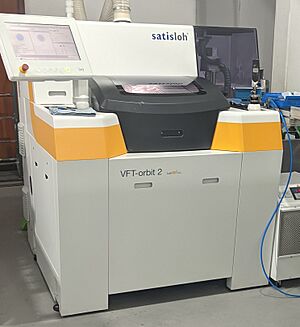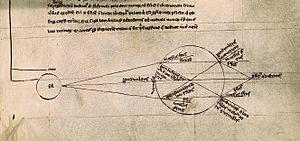History of optics facts for kids
Optics is the study of light and how it behaves. It looks at how light moves, how we see things, and how tools like lenses and mirrors work. The word optics comes from an old Greek word meaning 'appearance' or 'look'.
The story of optics began a very long time ago with people in ancient Egypt and Mesopotamia making early lenses. Later, ancient Greek thinkers came up with ideas about light and vision. Then, during the medieval Islamic period, there were big breakthroughs in understanding light, especially how it works physically and how our eyes see it. After that, in early modern Europe, new discoveries like diffraction (how light bends around corners) pushed optics even further.
These early studies are called "classical optics." "Modern optics" refers to the newer areas of research that mostly started in the 20th century, like wave optics (light as waves) and quantum optics (light as tiny particles).
Contents
Early Discoveries About Light
In ancient Greece, around 450 BCE, a philosopher named Empedocles had an interesting idea. He thought that everything was made of four basic things: fire, air, earth, and water. He believed that the goddess Aphrodite made the human eye from these elements and put fire inside it. This fire, he thought, shone out from our eyes, allowing us to see. But if that were true, we could see just as well at night! So, Empedocles also suggested that rays from our eyes mixed with rays from light sources like the sun to make sight possible. He even thought that light travels at a certain speed, not instantly.
Ancient China also made important discoveries in optics, separate from the Greek ideas.
How We See: Early Ideas
The Greek mathematician Euclid, who lived around 300 BCE, wrote a book called Optics. He noticed that "things seen under a greater angle appear greater." This means if an object takes up more space in your vision, it looks bigger. He used geometry to explain how big things appear based on how far away they are and the angle they make with your eye.
Later, around 55 BCE, a Roman thinker named Lucretius wrote about light. He observed that fires can send out light and heat over long distances without seeming to shrink.
Hero of Alexandria, who lived around 10-70 CE, used geometry to show something important about reflected light. He proved that when a light ray bounces off a flat mirror, it takes the shortest possible path from the light source to your eye. He also showed that an image in a flat mirror appears to be as far behind the mirror as the object is in front of it.
Understanding Vision with Geometry
Euclid started his study of optics with simple rules, just like he did with geometry. He said:
- Lines (or visual rays) travel in a straight line to an object.
- These lines form a cone shape when they hit an object.
- We see the things that these lines fall upon.
- Things that take up a larger angle in our vision appear bigger.
- Things seen by a higher ray appear higher.
- Right and left rays appear right and left.
- Things seen within several angles appear clearer.
Euclid didn't say what these "visual rays" were made of, but he used geometry to explain how perspective works and why distant objects look rounder.
Hero of Alexandria expanded on Euclid's ideas to include reflection. He thought that visual rays shot out from the eye at high speed, bounced off smooth surfaces, but could get stuck in rough surfaces. This idea is called the emission theory of vision.
Claudius Ptolemy, in his book Optics (around 100-170 CE), also believed that visual rays came from the eye. But he thought they formed a continuous cone, not separate lines. Ptolemy studied both reflection and refraction (how light bends when it passes through different materials like air, water, or glass). He measured how much light bent, but his results were not quite right because he thought the bending angle was directly related to the incoming angle, which isn't true.
Optics in the Islamic World
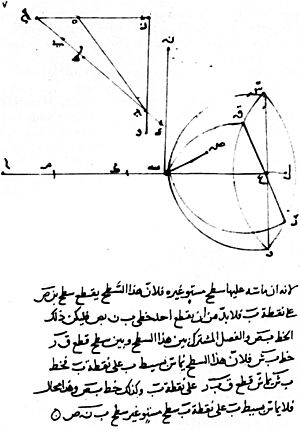
Al-Kindi (around 801–873) was one of the first important writers on optics in the Islamic world. He developed a theory that "everything in the world... emits rays in every direction." This idea that rays had an active power influenced later thinkers.
Ibn Sahl, a mathematician in Baghdad in the 980s, wrote about how curved mirrors and lenses bend and focus light. He also described a law for how light bends when it goes from one material to another, which is the same as what we now call Snell's law. He used this law to figure out the shapes of lenses and mirrors needed to focus light to a single point.
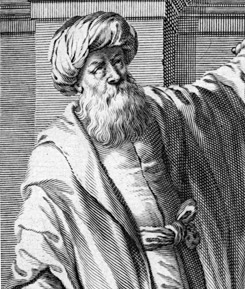
Ibn al-Haytham (known as Alhazen in Europe), writing in the 1010s, made huge progress. He disagreed with Ptolemy and insisted that vision happens because light rays enter the eye, not because rays come out of the eye. He also explained that these rays were actually forms of light and color. He then used geometry to study how these physical light rays behaved.
Ibn al-Haytham wrote many books on optics, with his most important being the Book of Optics. This book was translated into Latin and spread his ideas across Europe, greatly influencing the future of optics. He is often called "the father of modern optics."
Avicenna (980–1037) and Abū Rayhān al-Bīrūnī (973-1048) both agreed with Ibn al-Haytham that the speed of light is finite (it doesn't travel instantly). They thought light travels much faster than sound.
Later, in the late 1200s and early 1300s, Qutb al-Din al-Shirazi and his student Kamāl al-Dīn al-Fārisī continued Ibn al-Haytham's work. They were among the first to correctly explain the rainbow phenomenon.
Optics in Medieval Europe
The English bishop Robert Grosseteste (around 1175–1253) wrote about many scientific topics. He was interested in light, seeing it as a key part of how the universe works. He even had a theory about the origin of the universe that involved an expanding sphere of light, which some compare to a medieval "big bang" idea.
Another English thinker, Roger Bacon (around 1214–1294), was greatly influenced by Grosseteste's ideas about light. In his writings on optics, he used many ideas from Arabic scholars like Ibn al-Haytham. Bacon believed that every object sends out a "power" or "species" that allows it to affect nearby objects.
Several later books, like A Moral Treatise on the Eye by Peter of Limoges, helped spread Bacon's ideas.
John Pecham (died 1292), another English Franciscan, wrote the most popular optics textbook of the Middle Ages, called the Perspectiva communis. His book focused on how we see, following Ibn al-Haytham's model but interpreting it through Bacon's ideas.
Witelo (born around 1230) also wrote a large work on optics called the Perspectiva. His theory of vision followed Ibn al-Haytham's.
Theodoric of Freiberg (around 1250–1310) was one of the first in Europe to correctly explain how rainbows are formed, similar to the Islamic scholars Qutb al-Din al-Shirazi and Kamāl al-Dīn al-Fārisī.
Renaissance and Early Modern Optics
Johannes Kepler (1571–1630) deeply investigated the laws of optics. He studied unexplained things about lunar and solar eclipses, like strange shadow sizes and the red color of a total lunar eclipse. In 1604, he published The Optical Part of Astronomy, which is seen as the start of modern optics. In it, Kepler described how the intensity of light decreases with distance and explained how pinhole cameras work.
Willebrord Snellius (1580–1626) discovered the mathematical law of refraction, now known as Snell's law, in 1621. Later, René Descartes (1596–1650) used this law to show why a rainbow has an angular radius of 42°. He also independently discovered the law of reflection.
Christiaan Huygens (1629–1695) wrote important works on optics, including Treatise on Light.
Isaac Newton (1643–1727) made famous discoveries about light. He showed that a prism could split white light into a spectrum of colors (like a rainbow). He also proved that a lens and a second prism could combine these colors back into white light. Newton realized that objects don't create color themselves; instead, they interact with the colors already present in light. This is called Newton's theory of color.
Because of this, Newton concluded that refracting telescopes (which use lenses) would always have problems with colors separating. So, he invented the reflecting telescope, which uses mirrors to form images and avoids this color problem. In 1671, the Royal Society asked for a demonstration of his telescope, which encouraged him to publish his ideas in his book Opticks. Newton believed light was made of tiny particles called corpuscles, but he also had to consider them as waves to explain how light bends around obstacles (diffraction). Today, quantum mechanics and the idea of wave-particle duality show that light acts as both particles (photons) and waves.
Light Bending Around Objects
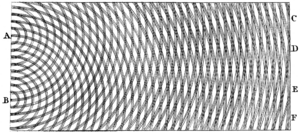
The bending of light around obstacles, called diffraction, was first carefully studied by Francesco Maria Grimaldi. He even coined the term diffraction, meaning 'to break into pieces'. His observations were published in 1665. Isaac Newton also studied these effects.
James Gregory (1638–1675) observed diffraction patterns made by a bird feather, which was like the first diffraction grating. In 1803, Thomas Young performed his famous double-slit experiment. He showed that when light passes through two tiny slits, it creates an interference pattern, proving that light behaves like waves.
Augustin-Jean Fresnel did more detailed studies and calculations on diffraction in 1815 and 1818. His work strongly supported the idea that light is a wave, which had been suggested by Christiaan Huygens and revived by Young, going against Newton's particle theory.
Lenses and How They Are Made
People might have used lenses in ancient times, thousands of years ago. Some think that glass eye covers in Egyptian writings from around 2600-2100 BCE were simple lenses. The Nimrud lens, a crystal object from the 7th century BCE, might have been used as a magnifying glass, or it could have just been a decoration.
The first clear written record of magnification comes from the 1st century CE. Seneca the Younger, a teacher of Emperor Nero, wrote: "Letters, however small and indistinct, are seen enlarged and more clearly through a globe or glass filled with water." Emperor Nero himself is said to have watched gladiatorial games using an emerald as a corrective lens.
Ibn al-Haytham (Alhazen) wrote about pinhole cameras, concave lenses, and magnifying glasses in his 11th-century Book of Optics. The English friar Roger Bacon, in the 1260s or 1270s, wrote about how corrective lenses for vision and burning glasses work, using ideas from Arab writers.
Between the 11th and 13th centuries, "reading stones" were invented. These were simple plano-convex lenses, often made by cutting a glass sphere in half. Monks used them to help read and create illuminated manuscripts. People soon learned that flatter lenses magnified better. Around 1286, possibly in Pisa, Italy, the first pair of eyeglasses was made, though we don't know who invented them.
The first working refracting telescopes appeared in the Netherlands in 1608. We don't know for sure who invented them, but Hans Lippershey and Jacob Metius both applied for patents that year. Galileo greatly improved these designs the next year. Isaac Newton is credited with building the first working reflecting telescope in 1668, his Newtonian reflector.
The earliest compound microscopes, which use two lenses (an objective lens near the specimen and an eyepiece), appeared in Europe around 1620. Like the telescope, we don't know who invented it. Claims include Zacharias Janssen and his father, Hans Martens, or Hans Lippershey, or Cornelis Drebbel.
Galileo Galilei also built his own improved microscope after seeing one in Rome in 1624. The name microscope was given to Galileo's device in 1625 by Giovanni Faber.
Quantum Optics: Light as Particles
Light is made up of tiny particles called photons, which means light comes in specific, small packets of energy. Quantum optics is the study of light when we think of it as these tiny, individual photons.
The idea that light might be made of these packets first came from Max Planck in 1899. He explained blackbody radiation by assuming that energy was exchanged in discrete amounts, which he called "quanta." In 1905, Albert Einstein explained the photoelectric effect by saying that light itself was quantized (made of these packets). Later, Niels Bohr showed that atoms can only release specific amounts of energy. These ideas helped create quantum mechanics, which is the study of the very small.
The field of quantum optics really grew with the invention of the maser in 1953 and the laser in 1960. Lasers are devices that produce very focused beams of light. Studying how lasers work led to a deeper understanding of light's properties, and that's when the name quantum optics became common.
Today, quantum optics researchers study things like how to create even shorter light pulses (attoseconds!), how to use quantum optics for quantum information (like in quantum computers), and how to control single atoms using light. They can even use laser beams to trap and move tiny objects or even clouds of atoms, a technique used to create Bose–Einstein condensation.
See also
- Giambattista della Porta
- List of astronomical instrument makers


